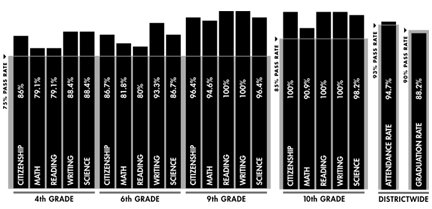                                                |
|
|
Percentage
of Yellow Springs Schools students who passed proficiency tests
in 2002, by subject With proficiency defined as:
75% of 4th, 6th and 9th grade students, and 85% of 10th grade students
passing,
93% attendance rate and 90% graduation rate districtwide
Source: Ohio Board of Education Local Report Card 2003Yellow Springs
News
|
 |
Yellow
Springs students pass 2002 proficiency tests—
Schools
score ‘Excellent’ on tests
Yellow Springs public schools received the highest possible ranking on
the Ohio 2003 Local Report Card.
For the first time, Yellow Springs received an “Excellent” ranking
based on last year’s proficiency tests, meeting 21 out of 22 state
standards. Other possible rankings are Effective (17–20 rankings),
Continuous Improvement (11–16), Academic Watch (7–10) and Academic
Emergency (0–6).
Out of 608 school districts, 109 received the Excellent ranking, according
to the Ohio Department of Education Web site, while 191 districts ranked
Effective, 257 ranked Continuous Improvement, 33, Academic Watch and 18,
Academic Emergency.
Last year, the first year in which an Excellent rating was offered, Yellow
Springs schools received an Effective ranking, meeting 21 out of 27 state
standards.
“We’re very happy that our students performed so well,”
Yellow Springs Superintendent Tony Armocida said this week. “The
results came from a combination of skilled, hardworking teachers, supportive
principals, a supportive community and good kids.”
Results were based on tests taken last spring and fall by fourth graders,
sixth graders and ninth and 10th graders. Most improved were the fourth
graders, who passed all of the state standards, compared to 2000–2001,
when they passed the writing standard but did not pass the standards in
reading, citizenship, science and math.
On the last tests, 86 percent of fourth graders passed the citizenship
test, compared to 69.8 percent the previous year, and 79.1 percent of
fourth graders passed the math test, compared to 69.8 percent in 2000–2001.
In reading, 79.1 percent of fourth graders passed the test, up from the
previous year’s score of 69.8 percent. In writing, 88.4 fourth graders
passed the test, while 95.3 percent passed in 2000–2001. And in science,
88.4 percent passed, compared to the previous year’s 69.8 percent.
Mills Lawn sixth graders passed all of the standards, as they had the
year before, with improved science scores, from 69.2 percent passing in
2000–2001 to 86.7 passing last year. Scores remained comparable in
the areas of reading, writing, citizenship and math.
Yellow Springs High School ninth graders maintained high scores on citizenship
(96.4 percent passing), math (94.6), reading (100), writing (100) and
science (96.4). Tenth graders who took the test, who had not passed when
in ninth grade, also had high scores, with 100 percent passing reading,
writing and citizenship, 90.9 passing math, and 98.2 passing science.
Yellow Springs missed a perfect score by failing to meet the state standard
in student graduation rate, as it has for the past several years. However,
the school’s graduation rate improved from 74.6 percent in 2000–2001
to 88.2 percent last year, missing the passing rate of 90 percent by 1.8
percent, Armocida said.
Because Yellow Springs numbers are so small, the graduation rate was brought
down by only a few students, he said. Plus, a few high school students
moved to Yellow Springs from another town, then returned to their original
towns but did not re-enroll in their original high schools, which counted
as their dropping out of YSHS, he said.
Several factors contributed to the rise in the scores of Mills Lawn fourth
graders, said Mills Lawn Principal Christine Hatton.
“We tried some new things,” she said, including using different,
less “overwhelming” workbooks to prepare for the tests than
were used previously, having an additional tutor for reading and a new
one in math, and working with students to “demystify” the tests
and help build up students’ comfort levels. Also contributing to
last year’s success were two new fourth grade teachers, said Hatton.
“We’re happy,” said Hatton regarding the test results.
However, she said, the importance of proficiency tests should not be overrated.
Rather than “teaching to the tests,” Mills Lawn teachers “just
incorporate the tests” in their regular curriculum. The tests are
useful, she said, in helping teachers “to figure out how we as teachers
can do better.”
Armocida also said that while the Yellow Springs community can be proud
of the proficiency tests results it should be even more proud of other,
more “authentic” kinds of learning the school provides, such
as hands-on projects, field trips and integrating the arts into the curriculum.
“I don’t want us to be judged only on this criteria, because
it’s so limited,” he said. “I’d rather we be judged
on whether or not our schools provide educational experiences for kids
that help them learn and grow.”
—Diane
Chiddister
|



